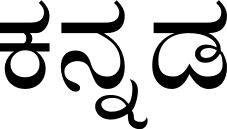Language/Kannada/Grammar/Negation
Hi Kannada learners! 😊
In this lesson, we will be discussing negation in Kannada language. Negation is the process of making a sentence negative. Understanding negation is important if you want to speak and write in Kannada with accuracy and fluency. So let's get started!
Negation Particles
In Kannada, the particles "alla" and "beda" are used to indicate negation in a sentence. "Alla" is used to negate nouns, while "beda" is used to negate verbs.
- Examples:*
| Kannada | Pronunciation | English |
|---|---|---|
| ನನ್ನ ಆತ್ಮಗೆ ದುಃಖ ಬಂದಿಲ್ಲ. | nanna aatmage dukha bandilla | I didn't feel sad. |
| ಅವನು ಹೋಗಿರಲಿಲ್ಲ. | avanu hogirallilla | He didn't go. |
| ನಾವು ಅವರಿಂದ ಖರೀದಿ ಮಾಡಲಿಲ್ಲ. | naavu avarindha kharida maadallilla | We didn't buy it from them. |
| ಆಹಾರ ಜಾಸ್ತಿ ತಿಂದಿಲ್ಲ. | aahaara jaasthi thindilla | I didn't eat much food. |
Double Negation
In Kannada, double negation is considered grammatically incorrect. Using two negative particles in a sentence makes the sentence positive. Instead of using two negative particles, only one negative particle should be used to indicate negation.
- Examples:*
| Incorrect Kannada | Correct Kannada | Pronunciation | English |
|---|---|---|---|
| ನನಗೆ ಹೋಗಲು ಇಚ್ಛೆಯಿಲ್ಲ ಅಲ್ಲ. | ನನಗೆ ಹೋಗಲು ಇಚ್ಛೆ ಇಲ್ಲ. | nanage hogalu ichhe illa alla | I don't want to go. |
| ಯಾರೂ ಕೇಳಲಿಲ್ಲ ಅಲ್ಲ. | ಯಾರೂ ಕೇಳಲಿಲ್ಲ. | yaaru kelallilla alla | Nobody asked. |
Negation of Present Tense Verbs
To negate present tense verbs in Kannada, the particle "beda" is used. The particle "beda" is added at the end of the verb, to negate it.
- Examples:*
| Kannada | Pronunciation | English |
|---|---|---|
| ನಾನು ಓದುವೆನು ಅಲ್ಲ. | naanu oduvenu alla | I am not reading. |
| ನೀನು ಬರುವೆಯೇ? ಅಲ್ಲ, ಬರುವೆನು ಇಲ್ಲ. | neenu baruveya? alla, baruvenu illa | Are you coming? No, I am not coming. |
Negation of Past Tense Verbs
To negate past tense verbs in Kannada, the particle "alla" is used. The particle "alla" is added at the end of the verb, to negate it.
- Examples:*
| Kannada | Pronunciation | English |
|---|---|---|
| ಅವನು ಆಟವನ್ನು ಆಡಲಿಲ್ಲ. | avanu aatavannu aadallilla | He didn't play the game. |
| ನಾನು ಎದ್ದಿಲ್ಲ. | naanu eddilla | I didn't wake up. |
Negation of Future Tense Verbs
To negate future tense verbs in Kannada, the particle "beda" is used. The particle "beda" is added at the end of the verb, to negate it.
- Examples:*
| Kannada | Pronunciation | English |
|---|---|---|
| ನಾನು ನೀಡುವೆನು ಅಲ್ಲ. | naanu needuvenu alla | I will not give. |
| ನೀವು ಹೋಗುವಿರಿಯೇ? ಅಲ್ಲ, ಹೋಗುವೆನು ಇಲ್ಲ. | neevu hoguviriye? alla, hoguvenu illa | Are you going? No, I am not going. |
Dialogue
- Person 1: ಹಳೆಯ ಪುಸ್ತಕ ಓದಲಾಗಲಿಲ್ಲ. (I didn't read the old book.)
- Person 2: ನೀನು ಹೇಳಿಕೆ ಕೊಟ್ಟಿಲ್ಲವೆ? ಎಲ್ಲಾ ಪುಸ್ತಕಗಳನ್ನೂ ಓದಬೇಕು. (Didn't you get the memo? You have to read all the books.)
Conclusion
Negation is an important concept in Kannada grammar. By understanding the use of negation particles in Kannada, you can easily make your sentences negative. Remember, double negation is grammatically incorrect in Kannada. Keep practicing and try creating your own sentences using negation particles.
To improve your Kannada Find native speakers and ask them any questions. You can also check out our Grammar section for more Kannada language lessons.
Sources
Videos
Framing Negative Sentence part 1 | English grammar in Kannada
Learn English Like Kannada 8 : Framing Negative sentences ...
Related Lessons
- How to Use Be
- Nouns
- Adjectives
- How to Use Have
- Pronouns
- Conditional Mood
- Future Tense
- Questions
- Gender

